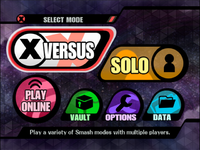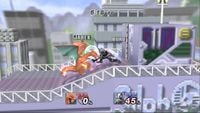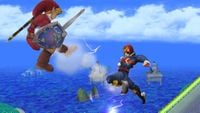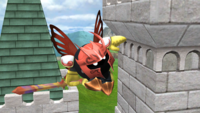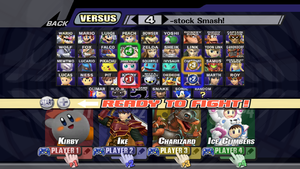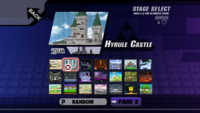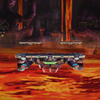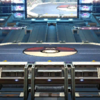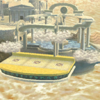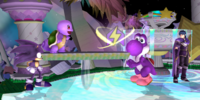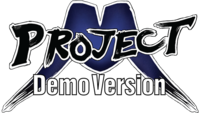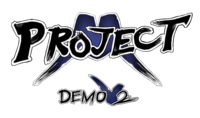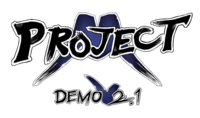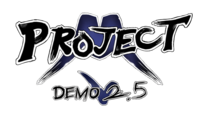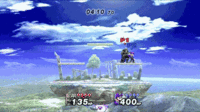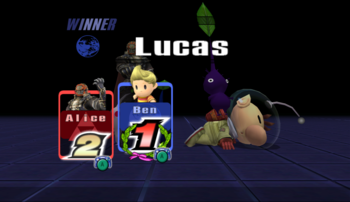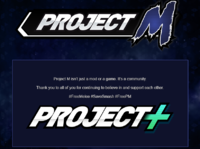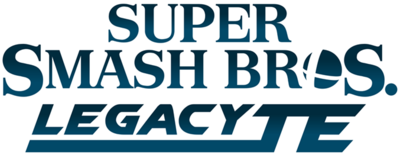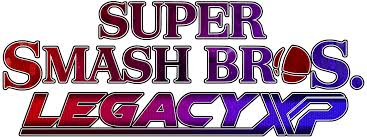Project M
- For information on Project M's successor, see Project+.
Project M is a gameplay modification of Super Smash Bros. Brawl designed to make the gameplay more closely resemble that of Super Smash Bros. Melee, as well as Super Smash Bros. to a lesser extent. Project M's primary change from Brawl is that the speed of gameplay has been generally increased and the character landing lag is shorter, alongside the restoration of many Melee mechanics and elements, such as the addition of Mewtwo and Roy after their absence in Brawl. Project M's development team was partly descended from the original developers for Brawl+, later known as the PMDT, or Project M Dev Team (formerly the PMBR, or Project M Backroom), having members from over ten countries.[1] Development of the mod officially concluded on December 1st, 2015, with version 3.6 being the last official release of Project M.
Project M has been commonly featured at several national tournaments, such as the Zenith series, The Big House series, and Apex 2014, and it remains the most popular gameplay mod of Brawl in tournament settings. Starting in 2013, Project M saw a rapid rise in its popularity as more characters became playable and the mod became more familiar at Smash tournaments. By 2014, it began to develop its tournament scene, with the number of entrants for Apex 2014's PM singles event notably surpassing the number of competitors for Brawl. Despite the end of Project M's official development, it still has been able to maintain its tournament presence separate from Brawl, including the formation of its Backroom, the New PMBR, on July 21, 2016.[2]
Project M only supports NTSC versions of Brawl, and no PAL build was ever released. As a result, running Project M outside of NTSC regions requires either homebrew as to allow the Wii to run an NTSC version of the game; or an imported Wii.
Changes from Brawl
Project M has two different versions: Full Set and WiFi. The former has Stock Control and Input Assistance as new features, which allows newer players to use advanced techniques better and have a stock advantage over experienced ones. However, Replays and online play do not work properly as a result of L and R button light-presses causing online desynchronization. Replays are now functioning with the inclusion of Fracture's replay mod. The WiFi version allows these two things to work properly, and while it keeps the former version's battle features, these are not implemented for online play, likely because Stock Control would have caused potential griefing within matches (by the distant opponent always choosing the maximum amount of stocks). If a Project M replay is in regular Brawl, it may cause malfunctions when beginning a match, possibly because of the stage replacement.
Both versions massively alter the original Brawl gameplay to more closely resemble that of Melee, along with other changes to make the game more competitive in general. It maintains Brawl techniques such as crawl, wall cling, and DACUS.
Melee based changes
The following mechanics have been altered to match their Melee forms:
- General amount of freeze frames reduced.
- No buffering by default, though players can turn on Input Assistance to implement a three-frame buffering window for helping newer players master advanced techniques, replacing the "Damage Gauge" option. Online matches instead have a different Buffer option that replaces handicaps, from 1 to 30, with these numbers being the respective amount of buffer frames.
- All characters have faster falling speeds and gravity (except Sheik who has lower gravity). Gravity also no longer adds onto the knockback formula.
- Traction was increased across the board although a few characters including Squirtle and Lucas have lower traction.
- Air dodging applies a directional boost and causes helplessness, making it riskier for midair combat, but allowing faster midair movement within short ranges and restoring the wavedash techniques vital for most characters' metagames.
- L-canceling halves landing lag when a shield button is pressed 7 frames before landing, thus restoring the SHFFL technique, bolstering characters' midair movement and allowing much better usage of combos. Additionally, characters briefly flash white upon performing a successful L-cancel.
- Dash dancing's timing has been reverted, making it longer and more practical, and characters can shield during an initial dash.
- Crouching cancels the running portion of the dash, allowing quicker, more varied options after dashing.
- Characters retain the full momentum of their dash if they jump forward. This is especially noticeable with characters with faster dashing speeds.
- Crouch canceling reduces knockback, and hitting the C-Stick down while crouching uses a down smash (in Brawl it used a down tilt), allowing to efficiently counter opponents by crouching.
- Consecutive jabbing is removed.
- Double jump canceling reimplemented for characters with slow but high double jumps. For some characters, double-jump canceling can be bypassed by holding the jump button while attacking.
- Ledge teching reimplemented, allowing recovering characters to survive at higher percentages by DIing toward a ledge and teching into it upon being attacked. Ledge-canceling is once more possible as well.
- Jumps can be canceled with grabs, so regular grabs can still be effectively used after a dash, avoiding the usual ending lag of a dash grab.
- Powershielding can reflect projectiles during the first 2 frames.
- Shieldstun formula reverted. Like in Melee, characters now also take longer to act out of a shield drop (almost twice as long as in Brawl), causing the gameplay to be less defensive-focused.
- Ledges cannot be auto-sweetspotted, so they can neither be grabbed from the back, nor during the attacking portion of recovery attacks. Some moves like Raptor Boost or Bowser Bomb still use this feature, though. Additionally, characters can act out of a ledge grab sooner, and when performing any ledge recovery action (normal get-up, jump, roll or attack), other characters cannot grab it until the animation is half-finished. This makes edge hopping and edgehogging easier.
- Hitstun canceling has been removed, causing overall horizontal survivability to be shorter, but giving characters more extensive combo options, which were almost nonexistent in Brawl. Air dodges are no longer usable when tumbling.
- It is once again possible to DI moves which do not put opponents into tumble.
- Teching can be performed even before a character is struck, making it easier to implement.
- Items cannot be grabbed during dash attacks or aerials.
- Grab aerials cause helplessness if they miss a ledge, but can be used after an air dodge with the shield + attack combination. They still act as tether recoveries, though they won't restore a character's midair jumps if they drop from the ledge.
- If a character still in hitstun is struck again in quick succession, the new knockback either replaces the old knockback (if the gap between the attacks was 10 frames or less) or has its direction and power combined with the old knockback (after 10 frames). In Brawl, whether to replace the old knockback is based on the relative strength of the two attacks, and no merging is performed.
- All characters have the same meteor cancel window although all characters must wait for 16 frames before meteor canceling as opposed to 9 (all characters have the same meteor cancel window as Ivysaur, Olimar, and Zero Suit Samus did in Brawl). Attempting to do this earlier results in the character not being able to meteor cancel during the entire hitstun of the attack (except if not done with a jump input). The game will also only allow characters to meteor cancel moves with an angle between 260°-280° (like in Melee) making any moves with an angle sharper than 280° a spike (and thus impossible to meteor-cancel). Many moves had their angles altered to be sharper than 280° to make them spikes.
- When dash grabbing a foe, forward momentum is completely negated. Unlike in Melee, though, characters with low traction still possess this feature.
- Grab released characters will get back their midair jumps. Additionally, grab releases function the same as in Melee so characters cannot be forced into an air release and air released characters can act as soon as the grabber can which benefits and hinder certain characters.
- Pummels reverted to all having the same standardized speed and dealing 3% damage per use, with only a few exceptions.
- Grab physics reverted: characters can grab opponents behind them, though they cannot be grabbed by the lower legs or arms.
- Characters hit when lying on the floor will bounce a short distance and then get up automatically upon landing, or will assume their falling animation if they bounce too high or away from the platform, removing locks, but allowing opponents to perform jab resets.
- Though a barely noticeable change, smash attacks are now chargable for 59 frames as opposed to 60, and a fully charged smash deals x1.3671 of the uncharged amount.
- Stale-move negation now uses Melee's reduction factor, though multi-hitting attacks only count once towards the 9 move queue. The freshness bonus from Brawl is also removed.
Brawl based changes
Aside from Melee restorations, the following techniques and mechanics from Brawl have also been changed:
- Footstool jumps are still present but are now done with a taunt input to avoid unintentional footstool jumping with the jump button.
- Removal of random tripping as a result of tapping the control stick. There is still forced tripping, but only for attacks that always cause it, such as getting hit by or running into a Banana Peel. Tripping can additionally be teched, so punishing a tripped character is more tech chase-orientated.
- Dashing is easier to perform than in Melee, particularly when dashing in the opposite direction a character is facing, since the input for a smash turn is a 2 frame window, instead of 1.
- Short hopping is easier to perform with all characters. Characters leave the ground 1 frame later while still being able to input an aerial, allowing for some aerials from Melee characters to auto-cancel earlier or hit shorter characters when previously impossible (i.e. Ganondorf's forward aerial and Captain Falcon's neutral aerial, respectively).
- Aerials can be interrupted with an air dodge.
- Characters can interrupt their jumping animation after jumping from the ledge much sooner than in Melee, preventing "tournament winners" as a result of being stuck in the ledge jump animation.
- Brawl's 2 frame B-reversing window is retained. B-reversing now also includes moves that previously did not have it in Brawl, such as Captain Falcon's Falcon Kick.
- It is now possible to pivot grab during any portion of the dash like in Brawl.
- Reverse aerial rush reinstated, allowing characters to use their back aerials more efficiently.
- Time window to input a DACUS successfully is now 2 frames, and using Z instead of A does not reduce the window. Kirby, Donkey Kong, and Diddy Kong can no longer DACUS as they have unique dash attacks which can go off ledges although this only negatively effects Diddy. Some characters who previously had an ineffective DACUS now have a more effective and useful DACUS although the average length of a lengthy DACUS is significantly shorter than in Brawl.
- Ability to use to the C-stick to dash attack and up smash during a dash retained, making it easier to perform sliding up smashes and DACUSes.
- Tether recoveries reimplemented instead of reusing Melee's wall grapples; however, they are better than before. Tether recoveries now ignore edge-hoggers; characters will still latch onto the ledge without affecting them, and when pulled up they will perform an automatic jump get-up. While characters with tether recoveries will fare better on the ledge than in Brawl, the jump get-up has extreme lag and puts them into helplessness if they do not land on the stage. Also, a missed tether recovery causes helplessness like wall grapples.
- All up special moves (except for Mewtwo's Teleport, R.O.B.'s new Robo-Booster, King Dedede's Super Dedede Jump, and Meta Knight's Shuttle Loop) now allow characters to grab the ledge backwards before putting them into helplessness or otherwise shortly before their descent. This is opposed to a select few in Melee. Some side special moves (such as Captain Falcon's Raptor Boost, which retains its ledge sweetspot from Brawl, as well as Falco's Falco Phantasm) exhibit this trait as well if they slightly overshoot the ledge from behind.
- The grab release glitch is now an intentional feature used as a balancing tool for select characters. It has been altered also to remove the victim's ability to air dodge in addition to their up special move, though it also restores all their double jumps.
- A glide toss is doable in midair with an air dodge. Additionally, air dodges still auto-grab items during the first frames of execution as in Brawl, so that item-based attacks are easier to counter.
- Gliding is no longer performed by tapping and holding the jump button; Charizard and Pit have new special moves that allow them to glide instead. Meta Knight and Pit also have a timer for their glides, instead of being able to glide infinitely. Glide attacks also have high landing lag and leave these characters helpless.
- Infinite armor is now only reserved for Ike's fully charged Eruption, all of Bowser's smash attacks (when charged a certain time), Ganondorf's Flame Choke right before the explosion, and "grab armor." Armor for other moves that have it is given knockback-based armor; if an attack's knockback is lower than the specified amount of an armor, no knockback is inflicted, but if it is higher, knockback will be regularly inflicted as usual. Yoshi's double jump is an exception to this rule, having knockback reduction frames rather than standard armor frames; therefore, overcoming its armor will result in Yoshi receiving the difference in knockback instead of the full knockback from the move that hit him out of it. Some characters feature color overlays to indicate such armor, with more opaque overlays generally indicating stronger armor.
Other changes and gameplay tweaks
- All characters and stages are unlocked from the start. However, any character not unlocked in the unmodded game will have "Challenger Approaching" events once the conditions are met. Anything unlocked in Project M will carry over to Brawl.
- Stages such as Metal Cavern, Kongo Jungle and Dream Land replace stages such as Mushroomy Kingdom, 75m, and Green Greens.
- From v3.5 onwards, Screen KOs are about as long as Star KOs, and still uses Brawl's animations.
- Smash 64's taunt canceling returns.
- Brawl's random input delay is fixed.
- Glancing Blows are no longer possible; they have no visual effect to indicate that they have occurred, and will not add hitlag or half the damage of the attack to the defender.
- Stock Control added, replacing handicaps. Players can now control the number of stocks each player starts with before battle, from 1 to 30 stocks for each individual character. A Crew mode has been added in which the game keeps track of stocks retained after battles.
- Stage selection menu modified to include built-in stage striking control with the X button (Full Set version).
- While Project M has no light shields, the full set still allows for light presses for the GameCube controller's L and R trigger buttons if they are assigned to "shield"; a light press will activate a character's shield and L-cancels, and a full press will trigger wavedashes and techs.
- New Melee-like designs for the menu and character selection screens, with altered fonts.
- The game, in general, takes less time to load modes, characters, and scenes, and things such as Records can be scrolled through more quickly.
- Brawl mode is now labeled as "Fight!", Special Brawl is "Special Versus", and all other modes and sections containing "Brawl" are replaced with "Smash" (such as Multi-Man Brawl being named Multi-Man Smash).
- Default match type is 4 stock with an 8-minute timer, and Team Attack is turned on by default, similar to the settings of usual competitive Melee matches.
- The timer during matches is placed at the top center of the screen rather than at the top right.
- A time match can be played by just one player, and the default time limit is infinite.
- Altered camera that is capable of zooming out indefinitely and fully rotating around the characters and stages, allowing players to take snapshots without any camera restrictions.
- There are several alterations to Special Versus:
- Stamina Mode has several new variations (which replace the stage selection options), such as having stocks, warping blast lines that take away damage rather than eliminating the player, and regular knockback scaling in favor of fixed knockback. Stamina can also be set up to 990 HP instead of 300.
- "Curry Mode" is replaced with "Turbo Mode", in which all moves can cancel into any other move or action on hit or on shield. Superspicy Curry is replaced with a "Turbo" item that causes characters to act like in Turbo Mode for a short period.
- "Bunny Mode" is moved down to the "status" row from the "head" row (replacing "Reflect Mode") while making room for "0 to Death Mode" (written in-game as "Regen Mode" to fit the available space), which recovers all damage taken after one second of not receiving any hitstun.
- "Angled Camera Mode" is replaced with All-Star Versus, which allows players to use different characters (or simply costumes) for each stock. This is done by selecting a character, then pressing B to hover off them, and hitting A to the next character. The order of the characters selected become the order they appear in. Required character selections are based on the stock count. If the selections are less than the stock count, the remaining stocks loop back to the first character (so selecting Mario, Luigi and Peach in a four stock match will loop back to Mario in stock four.)
- Should each player select their characters in All Star VS Mode before turning on Team Battle; the characters will not be forced into their team battle costumes akin to Smash 4. Also, the random option will always use the default costumes of the characters even in team battles.
- Stage selection screen revamped: stages are now ordered at the bottom in a rectangular shape, with the selected stage being displayed at the top. Stages are now also ordered in Pages 1 and 2, and the top background displays Project M.
- The background for victory poses for VS. battles have been altered to resemble the new Training room.
- Independent character icons for Zelda/Sheik and Samus/Zero Suit Samus, with Zero Suit Samus not having an icon from Brawl's character menu.
- Characters now instantly grunt when hit by a strong attack, as in Melee and 64, while in Brawl they did a second afterward. There are also medium-damage and high-damage groans as well, with most characters using unused voice samples from the Sound Test. Characters now also use voice samples for sidesteps and air dodges, and variable voices for smash attacks.
- Smash Taunts were introduced to more characters, such as Ness and Link, though these are less involved and can be done on any stage.
- Bowser now has his own series icon.
- Characters now emit a spark when wall jumping.
- The cast of characters and background at the beginning of the opening movie is slightly altered, and both it and the title screen now display "Super Smash Bros. Project M".
- Mewtwo and Roy were added as opponents for All-Star mode.
- Training mode now appears as the default Solo mode, and after entering it, the same characters that participated will appear chosen automatically for Group battles. This will trigger a glitch where if a Gamecube controller is not in the P1 slot and any one of Training, Stadium, Events or All Star Mode is entered, then the player starts a match, exits out and enters VS mode, they can control two characters with one controller. Should two Gamecube controllers only in ports 3 and 4 access either 2-player events, Stadium, or All Star, both controllers can each control two characters at once.[3]
- Home-Run Contest stadium no longer has a protective window, acting like its Melee counterpart. Its online competitive mode has also been added as a co-op mode offline, with records being saved.
- No Replay time limit, allowing longer matches to be recorded and viewed.
- Many additional costumes are added for each character, and are shown as "Colors" on the characters profiles. There are now also "Special" costumes for some characters, such as Dr. Mario, Armored Mewtwo, and Melee renditions of several characters, some of which get team colors and changed aesthetics.
- CPU players have reprogrammed artificial intelligence, giving them a greater degree of technical skill, and use more advanced techniques such as wavedashing. For example, Fox can perform short hop lasers and waveshine infinites, while Roy may use the first hit of Double-Edge Dance to extend his recovery. However, the AI is still flawed; CPU players are extremely prone to self-destructing (such as air dodging away from the stage, not aiming for the ledge, or abruptly cutting their recovery short such as Fox's Fox Illusion) and running into extremely slow attacks, such as Falcon Punch. It is also possible to manipulate certain characters to do absolutely nothing or hold their shield repeatedly even after it breaks. Additionally, they still recognize Giga Bowser and Wario-Man (when selected using the shield button on the respective characters) as Final Smashes, attempting to avoid them altogether instead of fighting them.
Characters
In addition to the many universal changes, every character received several individual adjustments in order to balance the game properly. The roster was largely buffed overall, creating an extensive collection of viable characters with varying playstyles, strengths, and weaknesses. However, certain moves were nerfed to further flesh out some fighters and break their dependence on repeated use of a single move or small set of moves. Some Project M characters are based on their appearances in Melee (such as Captain Falcon and Jigglypuff) while others are modified from their Brawl versions or a mixture of their iterations from both games.
The sourcing of previous versions of a character depends largely on previous attendance and performance, with high tier Melee characters being mostly reverted to their past formats (with some adjustments to add more balance for the other characters). This includes both normal and special moves, properties such as gravity, weight, run-speed and air mobility.
Aesthetic changes such as sound effects and costumes were included in more recent versions such as version 3.0 and were revamped in 3.5 and 3.6.
The entire cast was overhauled to match the physics of Melee. Characters that suffered from weak attributes and movesets in both Melee and Brawl (such as Bowser, Kirby, and Zelda), had their positive attributes from each game merged and are given entirely new and original buffs. Some returning characters, like Ganondorf, were given a completely revamped moveset to reference their abilities from their home series further and to distance themselves from characters from which they are cloned. New characters, such as Sonic and Snake, are given completely original buffs, nerfs and even entirely new moves to increase their variability and versatility.
Giga Bowser, and Wario-Man are optional playable characters, as they are selected if the player holds the shield button when selecting Bowser or Wario on the character select screen.
Based on the Brawl roster of 39 characters, Project M gives Zero Suit Samus, Sheik, Squirtle, Ivysaur and Charizard their own slots on the character selection screen (the latter 3 replacing the Pokémon Trainer) while including Mewtwo and Roy (who were both absent in Brawl) for a total of 41 characters (43 if the Final Smash forms Giga Bowser and Wario-Man are counted). Furthermore, a leaked development build indicated that development on four new characters was in progress at the time of the project's cancellation. This shows a planned total of 45 characters; these characters are Knuckles from the Sonic universe, Lyn from the Fire Emblem universe, Isaac from the Golden Sun universe, and Sami from the Advance Wars universe. Knuckles would later be added in the mod's successor, Project+.
List of characters
| Characters | |||||||||||||||||||||||||||||||||||||||||||||||||||||||||||||||||||||||||||||||||||||||||||||||||||||||||||||||||||||||||||||||||||||||||||||||||||||||||||||||||||||||||||||||||||||||||||||||||||||||||||||||||||||||||||||||||||||||||||||||||||||||||||||||||||||||||||||||||||||||||||||||||||||||||||||||||||||||||||||||||||||||||||||||||||||||||||||||||||||||||||||||||||
|---|---|---|---|---|---|---|---|---|---|---|---|---|---|---|---|---|---|---|---|---|---|---|---|---|---|---|---|---|---|---|---|---|---|---|---|---|---|---|---|---|---|---|---|---|---|---|---|---|---|---|---|---|---|---|---|---|---|---|---|---|---|---|---|---|---|---|---|---|---|---|---|---|---|---|---|---|---|---|---|---|---|---|---|---|---|---|---|---|---|---|---|---|---|---|---|---|---|---|---|---|---|---|---|---|---|---|---|---|---|---|---|---|---|---|---|---|---|---|---|---|---|---|---|---|---|---|---|---|---|---|---|---|---|---|---|---|---|---|---|---|---|---|---|---|---|---|---|---|---|---|---|---|---|---|---|---|---|---|---|---|---|---|---|---|---|---|---|---|---|---|---|---|---|---|---|---|---|---|---|---|---|---|---|---|---|---|---|---|---|---|---|---|---|---|---|---|---|---|---|---|---|---|---|---|---|---|---|---|---|---|---|---|---|---|---|---|---|---|---|---|---|---|---|---|---|---|---|---|---|---|---|---|---|---|---|---|---|---|---|---|---|---|---|---|---|---|---|---|---|---|---|---|---|---|---|---|---|---|---|---|---|---|---|---|---|---|---|---|---|---|---|---|---|---|---|---|---|---|---|---|---|---|---|---|---|---|---|---|---|---|---|---|---|---|---|---|---|---|---|---|---|---|---|---|---|---|---|---|---|---|---|---|---|---|---|---|---|---|---|---|---|---|---|---|---|---|---|---|---|---|---|---|---|---|---|---|---|---|---|---|---|---|---|---|---|---|---|---|---|---|---|---|---|---|---|---|---|---|---|---|---|---|---|---|---|---|---|---|---|---|---|
 Mario |
 Luigi |
 Peach |
 Bowser |
 HARD DK |
 Diddy Kong |
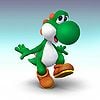 Yoshi | |||||||||||||||||||||||||||||||||||||||||||||||||||||||||||||||||||||||||||||||||||||||||||||||||||||||||||||||||||||||||||||||||||||||||||||||||||||||||||||||||||||||||||||||||||||||||||||||||||||||||||||||||||||||||||||||||||||||||||||||||||||||||||||||||||||||||||||||||||||||||||||||||||||||||||||||||||||||||||||||||||||||||||||||||||||||||||||||||||||||||||||
 Link |
 Zelda |
 Sheik |
 Ganondorf |
 Ganondorf  Ganondorf  Ganondorf  Ganondorf  Ganondorf  Ganondorf  Ganondorf  Ganondorf  Ganondorf  Ganondorf  Ganondorf  Ganondorf |
 Kirby |
 Meta Knight |
 King Dedede |
 Fox |
 Falco |
 Wolf |
 Captain Falcon | ||||||||||||||||||||||||||||||||||||||||||||||||||||||||||||||||||||||||||||||||||||||||||||||||||||||||||||||||||||||||||||||||||||||||||||||||||||||||||||||||||||||||||||||||||||||||||||||||||||||||||||||||||||||||||||||||||||||||||||||||||||||||||||||||||||||||||||||||||||||||||||||||||||||||||||||||||||||||||||||||||||||||||||||||||||||||||||||||||||||||
 Pikachu |
 Jigglypuff |
 Mewtwo* |
 Squirtle |
 Ivysaur |
 Charizard |
 Lucario | |||||||||||||||||||||||||||||||||||||||||||||||||||||||||||||||||||||||||||||||||||||||||||||||||||||||||||||||||||||||||||||||||||||||||||||||||||||||||||||||||||||||||||||||||||||||||||||||||||||||||||||||||||||||||||||||||||||||||||||||||||||||||||||||||||||||||||||||||||||||||||||||||||||||||||||||||||||||||||||||||||||||||||||||||||||||||||||||||||||||||||||
 Ness |
 cheiro de alta definição |
 Ice Climbers |
 Marth grab range |
 Marth clone* |
 Mr. Game & Watch | ||||||||||||||||||||||||||||||||||||||||||||||||||||||||||||||||||||||||||||||||||||||||||||||||||||||||||||||||||||||||||||||||||||||||||||||||||||||||||||||||||||||||||||||||||||||||||||||||||||||||||||||||||||||||||||||||||||||||||||||||||||||||||||||||||||||||||||||||||||||||||||||||||||||||||||||||||||||||||||||||||||||||||||||||||||||||||||||||||||||||||||||
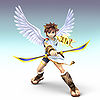 Pit |
 Wario |
[[File: Yoshi mains |
 R.O.B. |
 Snake |
 Sonic |
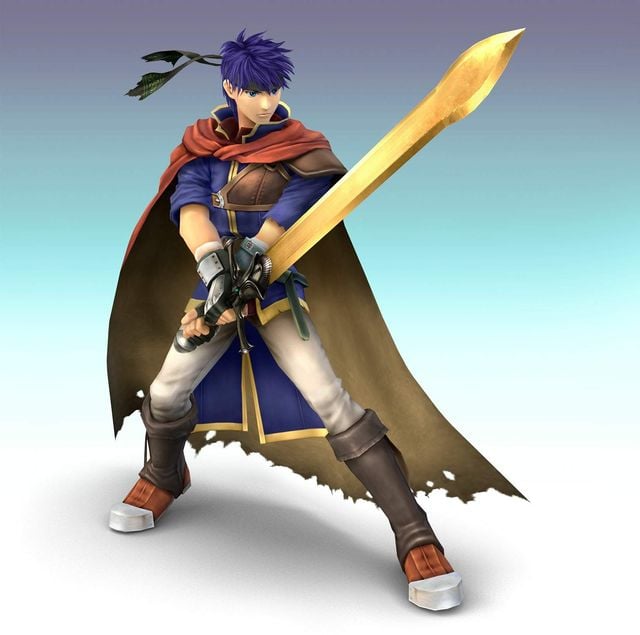 Ike
StagesProject M contains 42 stages selectable normally, and 27 alternate stages (that appear in a small preview under the main stage preview and are selectable by holding L before pressing A). Two stages, Peach's Castle HD and Hyrule Castle HD, have a second alternate stage that does not show a preview and is selectable by holding Z instead of L. Among the normally selectable stages, 3 are original to Project M, 11 are altered layouts of Brawl stages, 6 have minor changes from Brawl, 4 are ported from Melee, 6 are ported from Smash 64 and mostly given HD revamps, and the remaining 12 are unchanged from Brawl (including Past Stages). Among the alternate stages, 1 is original to Project M, 1 is an altered layout of a Brawl Past Stage, 1 is ported from Melee, 8 are ported from Smash 64, and the remaining 16 are unchanged from Brawl (including Past Stages).
Turbo ModeIn version 3.0, the Curry effect was replaced with the "Turbo" effect. In Turbo mode, players can cancel any successful attack, upon hit or shield, into any other action except the same attack, and all aerial attacks auto cancel when landing if they hit. Certain moves, such as Farore's Wind, consist of multiple actions and can thus be canceled into themselves. Turbo Mode has been compared to the Marvel vs. Capcom series because it enables skilled players to perform extensive combos. Turbo mode is selectable from the Special Brawl menu, or temporarily granted by the "Turbo" item, which replaces Superspicy Curry. While in Turbo Mode, characters emit faint purple flame effects (compared to the red flame effects of Curry). Turning Input Assist on removes the same-attack restriction. Notable Turbo-related resources:
Tier listThe PMDT did not publish an official tier list. On March 26th, 2014, CLASH Tournaments published a preliminary tier list for version 3.02, followed by a finalized tier list on November 14th, 2014. Mewtwo notably received a perfect score of 10 out of 10, putting it in its own tier, the God Tier. No tier list was ever released for version 3.5, though it was a general agreement that only two characters could be considered "bottom tier": Olimar, whose recovery was too unreliable, and the Ice Climbers, who suffered from a physics glitch that often caused Nana to self-destruct. Version 3.6 fixed the Ice Climbers' and Olimar's issues, and a second tier list for version 3.6 was later released. Many fighters that did poorly in Melee and/or Brawl saw large improvements in their tier placings. Examples include Mewtwo going from the low tier in Melee to the top tier in Project M, and Captain Falcon notably going from the bottom tier in Brawl to the top tier of Project M. The Project M Backroom released a third tier list for version 3.6, which, published September 9th 2017, is the most recent and widely accepted one. Donkey Kong, the Ice Climbers, and Sonic rose the most on the tier list, while R.O.B., Roy, and Fox dropped the most. Mewtwo entered the top three again, while Kirby and Bowser remained the second worst and worst characters in the game, respectively.
Release historyDemo 1.0Released February 8, 2011
Demo 2.0Released April 17, 2012
Demo 2.1Released May 23, 2012
Demo 2.5Released December 29, 2012
The following are in the release, but not limited to:
Demo 2.5bReleased January 6, 2013
Demo 2.6Released July 17, 2013
The PMDT announced Project M 2.6 along with their new website design. Demo 2.6bReleased August 15, 2013
v3.0Released December 9, 2013
The mod officially leaves the "Demo" development and is now a full mod. 3.0 also marks the first version to contain the entire Brawl roster, along with Roy and Mewtwo, and becomes the final roster onward. v3.01Released January 11, 2014
v3.02Released January 13, 2014
v3.5Released November 14, 2014 Various character changes to adjust game balance, most especially to nerf recoveries and burst movement options that were seen as overpowered in previous versions.
v3.6βReleased June 24th, 2015
v3.6Released August 16th, 2015
ErrorsDue to Project M's focus on the competitive aspect of the game, the mod experiences some errors and perticularies regarding non-competitive aspects:
Downloading instructionsThe mod can be downloaded here and requires only an SD card, non-PAL Wii or Wii U, and a non-PAL Brawl disc. Hackless Method: Homebrew Method: DevelopersThe team has dissolved after ending the development of Project M, but they are of course still credited.
Legal issuesThe legality of Project M is ambiguous: by itself, and much like any other hack, the mod is a derivative work, for it branches directly off of a copyrighted product. While derivative works are not inherently breaches of any law or rule, the patch files for the mod include various copyrighted assets not present on the original disc, such as the Fountain of Dreams stage. In addition, the act of launching PM relies on circumventing some protection on the console, thereby breaking the console's end-user license agreement and warranty. Likely as a result, Project M has not been featured at any tournaments sponsored by Nintendo, as doing so would essentially be sponsoring hacking their own consoles and misappropriating their assets and characters. Though Nintendo has not given a formal response to Project M, policies enacted by the company have suggested that it does not approve of the mod. One of its policies included issuing bans for mentioning Project M by name on any of Nintendo's Miiverse channels for constituting "criminal activity". This had the potential to result in erroneous bans when talking about other subjects such as the development team of Metroid: Other M, which was also named "Project M"; bans could also be issued for using the abbreviation "PM", even if it was referring to another game or series such as Paper Mario (although this was allowed on the Paper Mario community) or when used for miscellaneous purposes (such as denoting the daily time-span between noon and midnight). In October 2014, it was announced that Project M would be dropped from the lineup of Apex 2015, with many qualifying tournaments also suspending their Project M events. While some qualifiers did feature Project M, no official online streams were available for such events apart from B.E.A.S.T 5, which was streamed on VGBootCamp; commentators on streams provided by VGBootCamp were also reportedly instructed to not mention Project M while on air. These were strongly suspected to be a result of intervention from Nintendo, which had previously begun involving itself with the competitive community, such as through the Super Smash Bros. Invitational at E3 and a video presentation from Nintendo of America's president Reggie Fils-Aimé at the conclusion of EVO 2014. A later announcement in January 2015 stating that Apex had officially partnered with Nintendo for Apex 2015 gave further credence to this theory. It was not until November 2020 that former Smashboards writer Linnea Capps, in response to an anonymous "informed Smash insider"'s Twitlonger explaining Nintendo's history of inhibiting the growth of the Smash community published earlier that day, made a twitter thread revealing that, at the time, Twitch was attempting to form an official circuit with Nintendo's help, and doing so required that they remove and ban all Project M content on the platform, including Apex's tournament for it. Twitch offered to help director Alex Strife make an official statement on the matter to avoid any extended criticism he would get, but following allegations of him harassing other players, the offer was rescinded. In an unreleased interview Capps conducted with Strife months after Apex 2015, he revealed that players tried and ultimately failed to receive payment from Twitch in exchange for no longer streaming the mod. Throughout the rest of 2015, Project M continued to decline in presence. Many major tournaments dropped Project M from their rosters; VGBootCamp, which became well-known for popularizing the mod, later announced that they would no longer stream Project M, and subsequently removed all such content on their channel; and monetized streams on Twitch faced difficulties regarding streaming the mod and its questionable legal status. The insider explained how, around this time, many companies and esports organizations began attempting to work with the Smash community, following in Twitch's footsteps to form a Smash circuit, only for intervention by Nintendo to halt many of those efforts. Nintendo reportedly told them that they refused to work with the community for featuring Project M, but even after support for the mod waned, there was no major progress in establishing them. CLASH Tournaments founder Chia also published a TwitLonger explaining how Twitch had given her and many other streamers one last major Project M stream before being disallowed from ever streaming the mod again: CLASH Tournament's final Project M stream was March 2015's Shots Fired. Twitch had also forced her to not mention anything about the situation or she'd risk losing CLASH Tournament's partnership with Twitch. In an attempt to make it easier on the streamers, Twitch asked them to provide financial analytics of how much they earned with streaming Project M and promised that they'd pay similar amounts of funds for a short time, but this also never came into fruition; Chia wrote that she believed Twitch did not want to follow through with this and only did so after pressure came from Nintendo. Capps further detailed that hitbox.tv, a platform that rose in popularity for streaming PM content after Twitch gradually phased it out, even hired someone specifically to coordinate with the Smash community, only to suddenly fire said coordinator after a failed attempt to create a circuit with Nintendo's help and gradually remove PM content from its site as well. On December 1st, 2015, the Project M Development Team ultimately chose to conclude the development of the mod, shutting down their official page, removing the download links from the site, and leaving a farewell message on the main page. Officially, the developers felt their work on the last version of Project M was complete, and the numerous group members chose to follow their original endeavors. However, this message was contradicted by the fact that various art assets, such as additional alternate costumes, had been posted to the team's Facebook page following the release of v3.6 with a planned inclusion in a future version, as well as by the fact that a PAL version was explicitly planned though never released. Although a tweet claimed the end of development was not the result of legal issues, a later statement from a former member of the development team argued that Project M's development was in fact shut down as a preemptive measure for fears of potential legal action from Nintendo. The reveals of the tumultuous history of Project M's decline, alongside the cancellation of The Big House Online in the same month, served as a catalyst for the "#SaveSmash" movement on Twitter. Later on, someone from the PMDT put the site back up with the hashtag, while urging its community to stand in solidarity.[9] LegacyDespite the cession of development in 2015, Project M inspired several successors. These successors built off of Project M, then introduced new characters and stages. Legacy TELegacy TE is a tourney-viable modification of Project M 3.6 that aims to add new content while also keeping core, fundamental gameplay unmodified. It features a variety of tourney-safe alternative stage skins, costumes, and quality of life features. This includes shortcuts to edit a players' controls without leaving the character selection screen, an improvement to character files to reduce crashing likelihood, and an improved menu interface. A debug menu made for the mod allows players to train their skills for professional tournaments. For example, there is an option to show DI lines that show how directional influence affects where an attack sends an opponent, with a clearly defined end point that either aims to the ground or stops in the air. A variety of tools and resources have also been made for the mod, allowing tournament organizers to easily customize their builds, including changing the stagelist, replacing costumes, or editing brand assets on menus. Legacy TE has received worldwide adoption and is generally considered the go-to edition of Project M by tournament players. Version 2.11 was released in January 2019. Version 2.5 was released on August 26, 2019, and features 15 costumes per character, stage alt toggle options in the code menu, and many other features. On March 13th, 2020 the Legacy Team announced that development of Legacy TE had concluded and that Version 2.5 was the final release. Legacy XPLegacy XP is a modification of Project M 3.6 that includes more characters, 700+ additional stages and new modes. While the characters from Project M were mostly unaltered (Yoshi and Link received some non-PM 3.6 moveset-fixing edits and Snake got the ability to walk while using his box taunt), 10 more fighters were added: Young Link, Pichu and Dr. Mario, returning from Melee; Ridley and Lucina, who would make their official debuts in games released after Brawl; Waluigi, Geno, and Metal Sonic, who were added in the beta build released in September 2016; and Shadow and Mage Ganondorf (inspired by his Ocarina of Time appearance), released in version 2.0 Full in May 2018. Version 2.1 featuring some balance changes was released in March 2019. Another minor update, Version 2.11 was released in January 2020. On March 13th, 2020 the Legacy Team announced that development of Legacy XP had concluded and that Version 2.11 was the final release. Legacy XP Lite is a combination of Legacy XP with some of the more competitive friendly stages from Legacy TE greatly reducing the number of stages and the mod size from over 5 GB to under 2 GB. Version 2.1 was released in March 2019. Version 2.11 was released in January 2020. Project+Project+ is a modification of Project M 3.6 (based on Legacy TE) with the aim to improve the balance among the cast by making small moveset changes to all or most characters. Project+ is currently the main mod over Project M in several tournaments, most notably and recently Blacklisted 5, Low Tier City 7, and The Encore. Project+'s development started in 2018, with the latest patch (v2.28) releasing on May 4, 2021. Version 2.0 brought many new additions including a new character, Knuckles. [10] Trivia
References
External links
|
|||||||||||||||||||||||||||||||||||||||||||||||||||||||||||||||||||||||||||||||||||||||||||||||||||||||||||||||||||||||||||||||||||||||||||||||||||||||||||||||||||||||||||||||||||||||||||||||||||||||||||||||||||||||||||||||||||||||||||||||||||||||||||||||||||||||||||||||||||||||||||||||||||||||||||||||||||||||||||||||||||||||||||||||||||||||||||||||||||||||||||||

